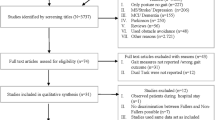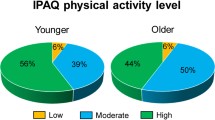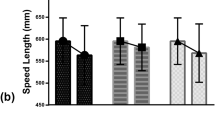Abstract
When a cognitive and a motor task like walking or keeping one’s balance are performed concurrently, performance usually deteriorates. Older adults have often been shown to prioritize their motor performance in such dual-task situations, possibly to protect themselves from falls. The current study investigates whether these prioritization behaviors can still be observed when several challenges are combined. Younger (20–30 years old) and older adults (60–70 years old; n = 24 in each group) were asked to walk through virtual environments with and without a cognitive load (3-back task). Walking difficulty was increased by walking on an elevated surface or on a narrow as opposed to a broad track, or both. Walking instructions emphasized speed and accuracy (avoiding missteps). No instruction was given concerning which performance dimension should be prioritized during dual-task trials. Participants decreased their 3-back performance while walking. Younger adults maintained their walking speed on elevated surfaces and were able to keep the number of missteps low, even when walking on a narrow track while performing the cognitive task. Older adults increased their walking speed on elevated relative to even surfaces and committed more missteps under cognitive load. Results suggest that task prioritization might fail in healthy older adults if several challenges are combined in high-risk settings.




Similar content being viewed by others
References
Barra J, Bray A, Sahni V, Golding JF, Gresty MA (2006) Increasing cognitive load with increasing balance challenge: recipe for catastrophe. Exp Brain Res 174:734–745. doi:10.1007/s00221-006-0519-2
Brehmer Y, Li S-C, Müller V, von Oertzen T, Lindenberger U (2007) Memory plasticity across the lifespan: uncovering children’s latent potential. Dev Psychol 43:465–478. doi:10.1037/0012-1649.43.2.465
Brown LA, Doan JB, McKenzie NC, Cooper SA (2006) Anxiety-mediated gait adaptations reduce errors of obstacle negotiation among younger and older adults: implications for fall risk. Gait Posture 24:418–423. doi:10.1016/j.gaitpost.2005.09.013
Cain CK, LeDoux JE (2008) Emotional processing and motivation: in search of brain mechanisms. In: Elliot AJ (ed) Handbook of approach and avoidance motivation. Psychology Press, New York, pp 17–34
Czienskowski P, Schellenbach M, Oertzen TV (2008) Feedback-controlled locomotion in virtual environments. In: Gulz A, Magnusson L, Malmborg H, Eftring H, Jönsson B, Tollmar K (eds) NordiCHI 2008: building bridges. ACM Press, New York, pp 447–450
Delbaere K, Sturnieks DL, Crombez G, Lord SR (2009) Concern about falls elicits changes in gait parameters in conditions of postural threat in older people. J Gerontol A Biol Sci Med Sci 64A:237–242. doi:10.1093/gerona/gln014
Gage WH, Sleik RJ, Polych MA, McKenzie NC, Brown LA (2003) The allocation of attention during locomotion is altered by anxiety. Exp Brain Res 150:385–394. doi:10.1007/s00221-003-1468-7
Hadjistavropoulos T, Carleton RN, Delbaere K et al (2012) The relationship between fear of falling and balance confidence with balance and dual tasking performance. Psychol Aging 27:1–13. doi:10.1037/a0024054
Hausdorff JM, Rios DA, Edelberg HK (2001) Gait variability and falls risk in community-living older adults: a 1-year prospective study. Arch Phys Med Rehabil 82:1050–1056. doi:10.1053/apmr.2001.24893
Hemmelmann C, Brose S, Vens M, Hebebrand J, Ziegler A (2010) Perzentilen des body-mass-index auch für 18-bis 80-Jährige? Daten der nationalen verzehrsstudie II. Dtsch Med Wochenschr 135:848–852. doi:10.1055/s-0030-1253666
Hornbrook MC, Stevens VJ, Wingfield DJ, Hollis JF, Greenlick MR, Ory MG (1994) Preventing falls among community-dwelling older persons: results from a randomized trial. Gerontologist 34:16–23. doi:10.1093/geront/34.1.16
Kelly VE, Janke AA, Shumway-Cook A (2010) Effects of instructed focus and task difficulty on concurrent walking and cognitive task performance in healthy young adults. Exp Brain Res 207:65–73. doi:10.1007/s00221-010-2429-6
Lajoie Y, Teasdale N, Bard C (1993) Attentional demands for static and dynamic equilibrium. Exp Brain Res 97:139–144. doi:10.1007/BF00228824
Lehrl S, Merz J, Burkhard G, Fischer S (1991) Manual zum MWT-A. Perimed Fachbuch Verlag, Erlangen
Li KZH, Lindenberger U, Freund AM, Baltes PB (2001) Walking while memorizing: age-related differences in compensatory behavior. Psychol Sci 12:230–237. doi:10.1111/1467-9280.00341
Li S-C, Lindenberger U, Hommel B, Aschersleben G, Prinz W, Baltes PB (2004) Transformations in the couplings among intellectual abilities and constituent cognitive processes across the life span. Psychol Sci 15:155–163. doi:10.1111/j.0956-7976.2004.01503003.x
Lövdén M, Schellenbach M, Grossman-Hutter B, Krüger A, Lindenberger U (2005) Environmental topography and postural control demands shape aging-associated decrements in spatial navigation performance. Psychol Aging 20:683–694. doi:10.1037/0882-7974.20.4.683
Makizako H, Furuna T, Shimada H, Ihira H, Kimura M, Uchiyama E, Oddsson LI (2010) Association between a history of falls and the ability to multi-task in community-dwelling older people. Aging-Clin Exp Res 22:427–432. doi:10.3275/6763
Mirelman A, Maidan I, Herman T, Deutsch JE, Giladi N, Hausdorff JM (2011) Virtual reality for gait training: can it induce motor learning to enhance complex walking and reduce fall risk in patients with Parkinson’s Disease? J Gerontol A Biol Sci Med Sci 66A:234–240. doi:10.1093/gerona/glq201
Nagamatsu LS, Voss M, Neider MB, Gaspar JG, Handy TC, Kramer AF, Liu-Ambrose TYL (2011) Increased cognitive load leads to impaired mobility decisions in seniors at risk for falls. Psychol Aging 26:253–259. doi:10.1037/a0022929
Neider M, Gaspar JG, McCarley JS, Crowell JA, Kaczmarski H, Kramer AF (2011) Walking and talking: dual-task effects on street crossing behavior in older adults. Psychol Aging 26:260–268. doi:10.0137/a0021566
Powell LE, Myers AM (1995) The activities-specific balance confidence (ABC) scale. J Gerontol A Biol Sci Med Sci 50:M28–M34. doi:10.1093/gerona/50A.1.M28
Rendon AA, Lohman EB, Thorpe D, Johnson EG, Medina E, Bradley B (2012) The effect of virtual reality gaming on dynamic balance in older adults. Age Ageing 41:549–552. doi:10.1093/ageing/afs053
Schaefer S, Krampe RT, Lindenberger U, Baltes PB (2008) Age differences between children and young adults in the dynamics of dual-task prioritization: body (balance) versus mind (memory). Dev Psychol 44:747–757. doi:10.1037/0012-1649.44.3.747
Schellenbach M, Lövdén M, Verrel J, Krüger A, Lindenberger U (2010) Adult age differences in familiarization to treadmill walking within virtual environments. Gait Posture 31:295–299. doi:10.1016/j.gaitpost.2009.11.008
Shumway-Cook A, Woollacott M (2000) Attentional demands and postural control: the effect of sensory context. J Gerontol A Biol Sci Med Sci 1:M10–M16
Shumway-Cook A, Woollacott M, Kerns KA, Baldwin M (1997) The effects of two types of cognitive tasks on postural stability in older adults with and without a history of falls. J Gerontol A Biol Sci Med Sci 52A:M232–M240
Siu K-C, Woollacott MH (2007) Attentional demands of postural control: the ability to selectively allocate information-processing resources. Gait Posture 25:121–126. doi:10.1016/j.gaitpost.2006.02.002
Siu KC, Lugade V, Chou LS, van Donkelaar P, Woollacott MH (2008) Dual-task interference during obstacle clearance in healthy and balance-impaired older adults. Aging-Clin Exp Res 20:349–354
Siu K-C, Chou L-S, Mayr U, van Donkelaar P, Woollacott M (2009) Attentional mechanisms contributing to balance constraints during gait: the effect of balance impairments. Brain Res 1248:59–67. doi:10.1016/j.brainres.2008.10.078
Verghese J, Kuslansky G, Holtzer R, Katz M, Xue X, Buschke H, Pahor M (2007) Walking while talking: effect of task prioritization in the elderly. Arch Phys Med Rehabil 88:50–53. doi:10.1016/j.apmr.2006.10.007
Verrel J, Lövdén M, Schellenbach M, Schaefer S, Lindenberger U (2009) Interacting effects of cognitive load and adult age on the regularity of whole-body motion during treadmill walking. Psychol Aging 24:75–81. doi:10.1037/a0014272
Wechsler D (1981) Wechsler Adult Intelligence Scale—revised (WAIS-R). Psychological Corporation, New York
Yang Y-R, Tsai M-P, Chuang T-Y, Sung W-H, Wang R-Y (2008) Virtual reality-based training improves community ambulation in individuals with stroke: a randomized controlled trial. Gait Posture 28:201–206. doi:10.1016/j.gaitpost.2007.11.007
Acknowledgments
We thank Paul Czienskowski for programming the adaptive treadmill task, and Julius Verrel and Nathaniel Boyden for helpful discussions. We also would like to thank Gabi Faust, Danilo Jagenow, Nina Lisofsky, Djamila Maleika, and Astrid Strey for their help with data collection. This work was supported by the Max Planck Institute for Human Development in Berlin.
Conflict of interest
The authors declare no conflict of interest.
Author information
Authors and Affiliations
Corresponding author
Rights and permissions
About this article
Cite this article
Schaefer, S., Schellenbach, M., Lindenberger, U. et al. Walking in high-risk settings: Do older adults still prioritize gait when distracted by a cognitive task?. Exp Brain Res 233, 79–88 (2015). https://doi.org/10.1007/s00221-014-4093-8
Received:
Accepted:
Published:
Issue Date:
DOI: https://doi.org/10.1007/s00221-014-4093-8




